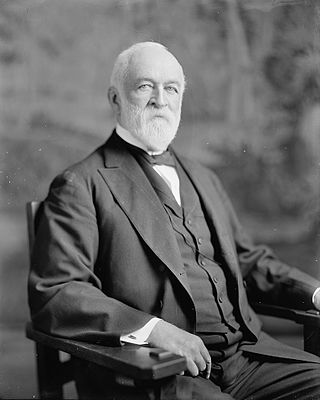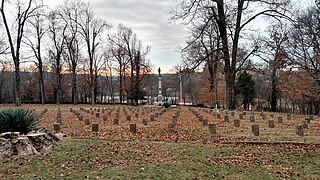
Cumberland County is a county located in the U.S. state of North Carolina. As of the 2020 census, the population was 334,508, making it the fifth-most populous county in North Carolina. Its county seat is Fayetteville. Cumberland County is part of the Fayetteville, NC Metropolitan Statistical Area.

Fayetteville is a city in and the county seat of Cumberland County, North Carolina, United States. It is best known as the home of Fort Bragg, a major U.S. Army installation northwest of the city.
The Battle of Averasborough or the Battle of Averasboro, fought March 16, 1865, in Harnett and Cumberland counties, North Carolina, as part of the Carolinas Campaign of the American Civil War, was a prelude to the climactic Battle of Bentonville, which began three days later.

The North Carolina State Capitol is the former seat of the legislature of the U.S. state of North Carolina which housed all of the state's government until 1888. The Supreme Court and State Library moved into a separate building in 1888, and the General Assembly moved into the State Legislative Building in 1963. Today, the governor and his immediate staff occupy offices on the first floor of the Capitol.

New Bern National Cemetery is a United States National Cemetery located in the city of New Bern, in Craven County, North Carolina. Administered by the United States Department of Veterans Affairs, it encompasses 7.7 acres (3.1 ha), and as of the end of 2005, had 7,517 interments. It is currently closed to new interments.

Charles Manly Stedman was a politician and lawyer from North Carolina.

James Graham Ramsay was a North Carolina physician and politician who served in the North Carolina Senate and Confederate States Congress during the American Civil War.

The Alabama Historical Commission is the historic preservation agency for the U.S. state of Alabama. The agency was created by an act of the state legislature in 1966 with a mission of safeguarding Alabama’s historic buildings and sites. It consists of twenty members appointed by the state governor or who serve in an official position. The members represent a broad cross section of Alabamians including architects, historians, archaeologists, and representatives of state universities. The commission is tasked with acquisition and preservation of historic properties and education of the public about historic sites in Alabama.

Bentonville Battlefield is a North Carolina state historic site at 5466 Harper House Road in Johnston County, North Carolina. It belongs to the North Carolina Department of Natural and Cultural Resources and is the site of the 1865 Battle of Bentonville, fought in the waning days of the American Civil War. It was declared a National Historic Landmark in 1996.

Elliott Daingerfield (1859–1932) was an American artist who lived and worked in North Carolina. He is considered one of North Carolina's most prolific artists.

This list includes properties and districts listed on the National Register of Historic Places in Cumberland County, North Carolina, United States. Click the "Map of all coordinates" link to the right to view a Google map of all properties and districts with latitude and longitude coordinates in the table below.

Fayetteville Confederate Cemetery is a cemetery for soldiers of the Confederate States located on the eastern side of Fayetteville in Washington County, Arkansas. Added to the National Register of Historic Places (NRHP) in 1993, the cemetery encompasses 3.5 acres (1.4 ha).
The Civil War Trust's Civil War Discovery Trail is a heritage tourism program that links more than 600 U.S. Civil War sites in more than 30 states. The program is one of the White House Millennium Council's sixteen flagship National Millennium Trails. Sites on the trail include battlefields, museums, historic sites, forts and cemeteries.
Ellerslie is a historic plantation house located near Linden, Cumberland County, North Carolina. It was built about 1790, and is a 1 1/2-story, six bay by two bay, Georgian style frame dwelling with a two-story Greek Revival style addition. It features a wide shed porch with plastered cove ceiling.

Fayetteville Downtown Historic District is a national historic district located in Fayetteville, Cumberland County, North Carolina. It encompasses 113 contributing buildings, 3 contributing sites, 1 contributing structure, and 2 contributing objects in the central business district of Fayetteville. The district includes commercial buildings, government and civic buildings, railroad-related structures, residential dwellings, churches and the Cross Creek Cemetery. They range in build date from the 1780s to 1949. The district includes the previously listed Liberty Row and Market House Square District and 16 resources listed as part of the "Historic Resources of Fayetteville," a Multiple Resource Nomination.

Confederate Breastworks is a historic breastworks located at Fayetteville, Cumberland County, North Carolina. The earthen bunkers are located on the grounds of the Fayetteville Veterans Administration Hospital behind the main building. They were built in March 1865 as part of the fortification of Fayetteville by the Confederate army to protect the city against the oncoming forces led by General William Tecumseh Sherman.

Fayetteville Veterans Administration Hospital Historic District is a national historic district located at Fayetteville, Cumberland County, North Carolina. It encompasses 8 contributing buildings, 1 contributing site, 1 contributing structure, and 1 contributing object on the medical center campus. They include the main building/outpatient clinic (1939), service building (1939), manager's quarters (1939), attendants’ quarters (1939), laundry building (1939), the flag pole (1939), and the attendants’ quarters (1939). Also located in the district is the separately listed Confederate Breastworks.
The following is a timeline of the history of the city of Fayetteville, North Carolina, USA.

The Mill Springs Battlefield National Monument was the location of the Battle of Mill Springs in January 1862. It was declared to be a U.S. National Historic Landmark in 1993 and authorized as a national monument in 2019. After acquisition of property by the National Park Service it was established as a unit on September 22, 2020.





















